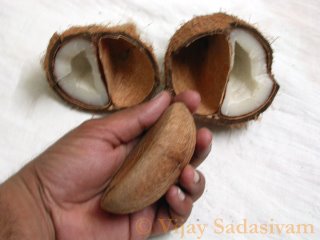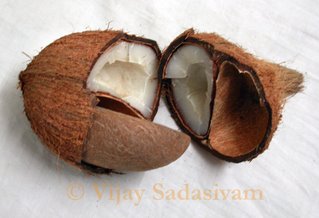The Lonely planet guide “Rarotonga and the Cook Island” tells us the following story. “In the centre of Avarua, capital city of the Cook Islands, just to the east of the traffic circle is a group of seven tall coconut trees growing in a perfect circle. Tradition has it that they are really all one tree! Supposedly in the distant past an amazing coconut with seven sprouts was found in the Island of Tatukea, near Atiu, and brought here to be planted. Papa Tangaroa Kainuku, oral historian of Rarotonga and Tumu Korero (speaker) of Kainuku Ariki, tells a different story about the trees, however. Apparently his grandfather, Frederick Goodwin, brought seven coconuts (not one) from Manihiki when he returned to Rarotonga sometime around 1900, and planted the seven trees in a circle here to commemorate the birth of his daughter, Papa Tangaroa’s mother, Te Ariki Vaine Akakino Ia E Te Vaa Tangata I Taputapuatea, who was born on 6 November 1898 while Goodwin was away in Manihiki. The circle of trees marked the boundary between Kaviri on the east, belonging to Makea Nui Ariki, and Tura’i on the west, belonging to Karika Ariki.”
During almost a century, people of Rarotonga picked seednuts from the Seven-in-one coconut palm to plant it in their field or in their home garden. Some of them tell me that they tried it in order to know how much sprouts will grow from each seednuts. The people I meet obtained one sprout only for each seednuts, anyway.
So we decided to sample these seven palms for DNA analysis and to harvest their fruits as a population, namely Cook Island Tall Seven-in-one (COKT01). Piri Puruto III, the great coconut climber of Rarotonga, accepted to climb the seven-in-one coconut palms ; he did it by following strictly the old Polynesian way, and he collected fruits and leaflets samples. Because of the story, a TV interview has been done and the COGENT activities and research programmes were presented to all the country under the supervision of the ministry of Agriculture.
The Seven palms were sampled for leaflets; DNA Molecular Analysis should at least let us know if these palms are real twins, full-sib, half-sib or unrelated. About 105 seednuts were collected, but many of them were already germinated on the palm or too young. According to the Polynesian tradition, some of the seednuts had to be left to the climbers, and it was not possible to escape it. We obtained only 60 albumen cylinders that finally gave 52 excised embryos cultivated in Vitro at the South Pacific Commission Lab.
Picture of palms and fruits were done. One fruit per palm was kept and Tiara Mataora will have to weigh the fruit component analysis in order to complete the data. Palm n°82 seems a little different from others because it was bearing many already germinated dry fruits.
I should like to thank the colleagues and partners who helped to ensure that this mission in Cook Islands took place under good material and scientific conditions. Special thanks to Messrs Mark Brown, Secretary of Agriculture, and M. Tiara Mataora, from the Ministry of Outer Island Development, along with their colleagues at Tototoiku Research Station. Another special thanks to Piri Puruto III, the great coconut climber of Rarotonga, who accepted to climb the seven-in-one coconut palms located in the central place of Avarua, the capital of the Cook Island. Indeed, it was not easy, for a man again strong but aged 59 years, to harvest seednuts and top leaflets samples by a day of hard wind, from palms aged more than 100 years.
02/04/2000: Sunday, day off. Meeting with M. Piri Puruto III, the great Coconut climber, in order to convince him to make a show in the local TV and to harvest seednuts and leaflet samples from the Seven-in-one Coconut palms at Avarua.
08/04/2000: Saturday, day off. Meeting with local TV, Marc Brown and Piri Puruto III. Climbing and Harvest of the Seven-in-one Coconut palms filmed by the TV.
11/04/2000: Extraction of the last 100 embryos for the tall population of Papaaroa school. Harvest of the 5 other palms of the Seven-in-one Coconut Palm by a young coconut climber. Harvest of the soft husk Coconut in Paparua School (seednuts and leaflets). Sending a Fax to Fiji Quarantine services.
12/04/2000: husking and extracting the embryos for the populations Cook Island Tall Seven-in-one and Soft Husk. Pictures of the fruits. Visit to a doctor (I was sick). Preparation of the last leaflets samples. Meeting with Gerald McCormack, director of the Cook Islands Natural Heritage project.
02/04/2000: Sunday, day off. Meeting with M. Piri Puruto III, the great Coconut climber, in order to convince him to make a show in the local TV and to harvest seednuts and leaflet samples from the Seven-in-one Coconut palms at Avarua.
08/04/2000: Saturday, day off. Meeting with local TV, Marc Brown and Piri Puruto III. Climbing and Harvest of the Seven-in-one Coconut palms filmed by the TV.
11/04/2000: Extraction of the last 100 embryos for the tall population of Papaaroa school. Harvest of the 5 other palms of the Seven-in-one Coconut Palm by a young coconut climber. Harvest of the soft husk Coconut in Paparua School (seednuts and leaflets). Sending a Fax to Fiji Quarantine services.
12/04/2000: husking and extracting the embryos for the populations Cook Island Tall Seven-in-one and Soft Husk. Pictures of the fruits. Visit to a doctor (I was sick). Preparation of the last leaflets samples. Meeting with Gerald McCormack, director of the Cook Islands Natural Heritage project.







